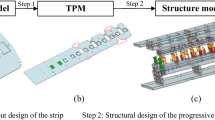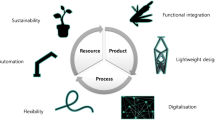Abstract
Inserts are real operating components for producing sheet metal part features when the press moves up and down. The complexity, cost and durability of a progressive die depend largely on the number of inserts and the design of different groups of inserts. In addition, the accuracy of metal stampings also greatly relies on the structure of the functional insert groups and their assembly. Thus, the design of inserts is a critical operation to a designer in terms of the design quality and productivity. In this paper, a flexible and complete insert representation scheme has been proposed. The complex assembly relationships and constraints between inserts and components are analyzed. The design automation of inserts using the knowledge-based approach is introduced. Finally, some results obtained using the proposed approach are given.
Similar content being viewed by others
References
Huang K, Ismail HS, Hon KKB (1996) Automated design of progressive dies. In: Proceedings of the Institution of Mechanical Engineers Part B: J Eng Manuf 210:367–376
Li Z, Chen Z, Hong Y, Xiao X, Xiao J (1990) Computer aided design of progressive die construction. In: Proceedings of the International Conference on Die and Mould Technology, Shanghai, , May 18–21, pp 357–363
Lin ZC, Chang H (1994) An investigation of an expert systems for die design. J Intell Manuf 5:177–192
Choi SH, Wong KW (1992) A CAD/CAM package for sheet metal blanking dies. In: Proceedings of the International Conference on Manufacturing Automation, Hong Kong, 10–12 August 1992, pp 674–679
Prasad YKDV, Somasundaram S (1992) CADDS: an automated die design system for sheet metal blanking. Comput Control Eng J 3:185–191
Cheok BT, Nee AYC (1998) Trends and developments in the automation of design and manufacture of tools for metal stampings. J Mater Process Technol 75(1–3):240–252
Choi JC, Kim C, Yoon JH (2000) An automated CAD system for progressive working of irregular shaped metal products and lead frame for semiconductors. Int J Adv Manuf Technol 16:624–634
Kim C, Park YS, Kim JH, Choi JC (2002) A study on the development of computer-aided process planning system for electric product with bending and piercing operations. J Mater Process Technol 130–131:626–631, 20 December 2002
Choi JC, Kim C (2001) A compact and practical CAD/CAM system for the blanking or piercing of irregular shaped-sheet metal products for progressive working. Journal of Materials Processing Technology 110, 36-46, 2001
Shin H, Olling GJ, Chung YC, Kim BH, Cho SK (2003) An integrated CAPP/CAM system for stamping die pattern machining. Comput Aided Des 35:203–213
Bruegge B, Dutoit A (2000) Object-oriented software engineering: conquering complex and changing systems. Prentice-Hall, New York
Booch G (1994) Object-oriented analysis and design with application. Benjamin/Cummings
Feng CX, Huang CC, Kusiak A, Li PG (1996) Representation of functions and features in detail design. Comput Aided Des 25(12):961–971
Paquin JR, Crowley RE (1987) Die design fundamentals. Industrial Press, New York, N.Y.
Author information
Authors and Affiliations
Corresponding author
Rights and permissions
About this article
Cite this article
Jiang, R., Lauw, B. & Nee, A. Insert design automation for progressive dies. Int J Adv Manuf Technol 28, 279–285 (2006). https://doi.org/10.1007/s00170-004-2370-6
Received:
Accepted:
Published:
Issue Date:
DOI: https://doi.org/10.1007/s00170-004-2370-6




